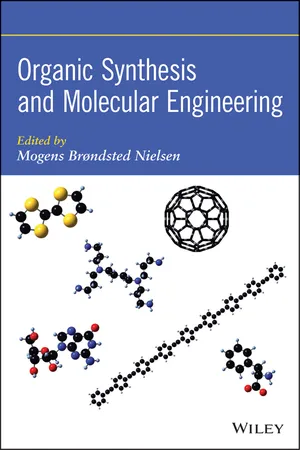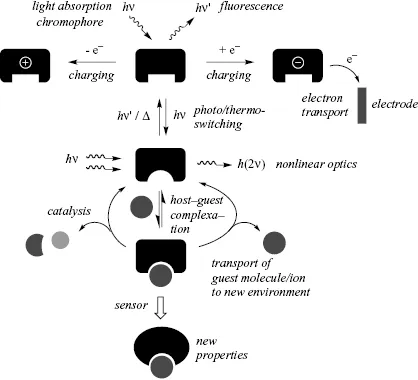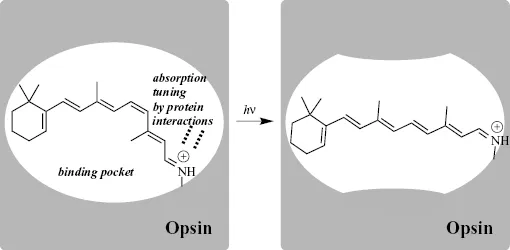Molecular engineering is an interdisciplinary research field, where design, synthesis, and manipulation of molecules and molecular assemblies are used to create advanced functions. Molecular engineering is an inherent part of nanotechnology and often involves manipulation of molecules at the nanoscale. The synthesis of organic molecules is usually the first experimental step to take whether the overall aim is to develop a nanomachine or molecular motor, a memory device, or an artificial enzyme that can catalyze specific transformations. Organic synthesis is therefore an integral part of this book, and several chapters have a special emphasis on synthetic protocols. With respect to the molecular and supramolecular function, the field of molecular engineering is relevant to a broad range of disciplines, from materials science, molecular electronics, environmental chemistry, chemical biology to pharmaceutical science. Some important targets are molecule-based computers (faster and smaller than silicium-based ones), intelligent drug delivery systems, organic molecules that are as efficient as enzymes for performing catalytic reactions but structurally much simpler (by being much smaller), peptide engineering of new catalysts, molecular sensors, materials for optical data storage, new electrically conducting materials, and new energy-storage materials. This book attempts to cover broadly these fields via chapters of which some are very general and some more specific. The chosen topics described in the chapters present a selection of important scientific contributions that have been made. Many other important contributions could have been covered in a book with such a broad title, but at least I hope that the reader will get an impression of the rich possibilities that exist to create molecules and supramolecular systems with unique properties and functions from those examples covered in this book.
The book is organized as follows. Chapter 2 gives an overview of useful molecular building blocks, covering, for example, different chromophores, redox-active molecules, photoswitches, peptide building blocks, macrocyclic receptors, and examples of how they can be integrated in advanced systems with specific functions. Some of these units are particularly useful in the design of molecular electronics components, which is the focus of Chapter 3. According to Moore's law [1], the number of components on integrated circuits doubles approximately every 2 years. Nobel Laurate Richard P. Feynman stated in his famous talk in 1959 at an American Physical Society meeting at Caltech that “There is plenty of room at the bottom,” which can be considered the start of nanotechnology and the idea of using a “bottom-up” manufacturing technique by self-assembly of suitable molecules. Thus, development of molecules as components for molecular electronics may provide a way to extend Moore's law beyond the limits of small-scale conventional silicon-integrated circuits. Carbon allotropes are also successfully exploited in this field as well as in organic photovoltaics, and production and functionalization of carbon nanotubes and graphene (single sheets of graphite) are covered in Chapter 4. For achieving functional devices and nanomachines, self-assembly of the molecular components in a desired manner is crucial. Chapter 5 describes how hydrogen bonding interactions can be employed for obtaining self-organizing nanostructures. By rational design of the structural parameters of the single molecular modules and by a strict control of the solvent and temperature conditions, it is possible to produce supramolecular polymeric materials possessing different geometrical structures such as nanofibers, two-dimensional organic networks, vesicles, or toroids.
Exploitation of solar energy is the focus of Chapter 6 and in particular how to store energy in chemical bonds by light-induced isomerization reactions. As described in this chapter, some of several challenges are to harvest light at the right wavelengths and to release the stored energy as heat in an efficient way when needed. Photoswitchable compounds are also central to Chapter 7, which describes strategies to switch fluorescence of photochromic oxazines. Such photoswitchable fluorophores have potential for the visualization of biological samples with subdiffraction resolution.
Supramolecular chemists have, over the last decades, developed a wide variety of macrocyclic receptors for binding of ionic or neutral guests. Specific efforts have focused on transducing the host–guest recognition process in a redox event, targeting sensors, smart materials, or devices for molecular electronics. Such redox-responsive systems are the focus of Chapter 8. The subsequent chapter shows how a chemosensor for nitroaromatic explosives, based on color changes, is designed, improved by systematic variation of the chemical structure, and how this molecule can be integrated into different solid-state devices.
Development of artificial receptors for substrates in water is particularly challenging, but central for engineering of biomimetic systems. In Chapter 10, the focus is recognition of carbohydrates in water and the different techniques used to evaluate this process. Carbohydrates are involved in the metabolic pathways of living organisms and play a crucial function in the first step of cell–cell, cell–virus and cell–bacteria interactions. Chapter 11 describes the development and synthesis of artificial enzymes based on cyclic oligosaccharide receptors, so-called cyclodextrins, which can bind substrates in a hydrophobic cavity and catalyze their conversion to specific products via suitably located catalytically active groups. The subsequent chapter covers another class of catalysts, organozymes, based on rationally designed peptides. Peptide-based catalysts that display some of the qualities of enzyme conversions have been developed in an approach partly based on the application of combinatorial methods. While natural enzymes have evolved to be efficient and selective through millions of years, combinatorial evolution in the laboratory can be performed rapidly within a few years. Catalysis and/or transport can also occur inside so-called dendrimers, which are classes of highly branched “tree-shaped” nanosized molecules. Exploitation of these molecules in biology and nanomedicine and the synthetic strategies to achieve them are covered in Chapter 13. Chapter 14 describes how reversible formation of host molecules can be used to identify the most suitable receptors for substrates in water, a field which is termed dynamic combinatorial chemistry. In this approach, the most suitable molecule is selected—“survival of the fittest” at the molecular level.
2.1 Molecular Function
Organic engineering of advanced molecules and supramolecular assemblies requires a variety of molecular modules with specific functions and properties, as shown schematically in Figure 2.1. Redox activity is an example of an important function, which allows charging of the organic molecule, either by removal or by donation of electrons. π-Conjugated molecules are often redox active and are usually also conveniently used as wires for electron transport (conductance). We also need building blocks that can absorb and emit light at specific wavelengths (chromophores and fluorophores) or that can undergo light or thermally induced structural changes (photo/thermoswitches) to form molecules with new properties. We need structural motifs that allow complexation of specific guest molecules or ions in various media via noncovalent interactions. Such molecular hosts may concomitantly act as catalysts for the chemical conversion of the guest molecules, substrates, into new products, thereby mimicking enzymes, or they could act as carriers for transporting the guest molecules from one phase to another, for example, through a cell membrane. Host–guest complexation may also alter properties such as fluorescence, which can be employed in the design of molecular sensors. Other important molecular properties include Brønsted and Lewis acidity and basicity, chirality, dipole moment, magnetic properties, nonlinear optical (NLO) and two-photon absorption properties, liquid crystallinity, solubility in polar (in particular, water) or nonpolar solvents, and not least, chemical stability and photostability.
Altered properties of the functional unit by virtue of interactions with its surroundings should also be taken into account. For example, chromophores can exhibit solvatochromism and hence exhibit different absorption maxima in different solvents. Absorption tuning is particularly important for the action of many proteins, such as opsin proteins present in the eye. These proteins are involved in the process of vision. The entire visible region is covered by three different cone pigment cells, each containing photoactive transmembrane proteins. While the chromophore is identical in these proteins, namely, a protonated retinal Schiff base linked to a specific lysine residue, the protein-binding pockets differ slightly in the three types of cones. By subtle protein–chromophore interactions, one protein tunes the chromophore absorption maximum to blue, one to green, and one to red light [1–3]. As shown in Scheme 2.1, the absorption of light induces a cis to trans isomerization of a double bond in retinal; this is the primary event in visual excitation and alters the geometry of the retinal in the protein-binding pocket, which triggers a cascade of processes [1]. Along the same line, the green fluorescent protein (GFP), which absorbs blue light and emits green light, provides a rigid environment for its chromophore (a 4-hydroxybenzylideneimidazolinone, Figure 2.2), which is only very weakly fluorescent in solution, but inside the binding pocket, fluorescence is turned on. On account of its fluorescent properties, GFP is widely used as a marker protein in molecular and cell biology [4–6].
Systems can be cleverly engineered that couple together individual functions, such as light absorption, energy transfer, and electron transfer, which is of importance when constructing, for example, photovoltaic cells or artificial photosynthesis systems. A selection of specific molecular building blocks will be provided in this chapter, and a few advanced systems will be discussed. Some reaction types useful in synthesis will also be presented, of which several will be encou...



